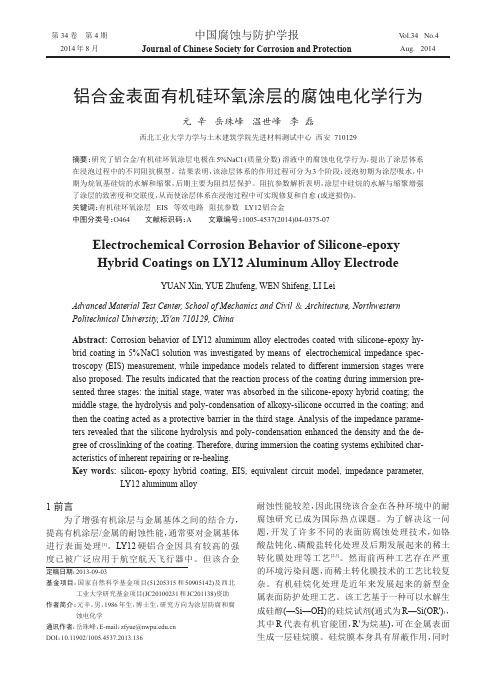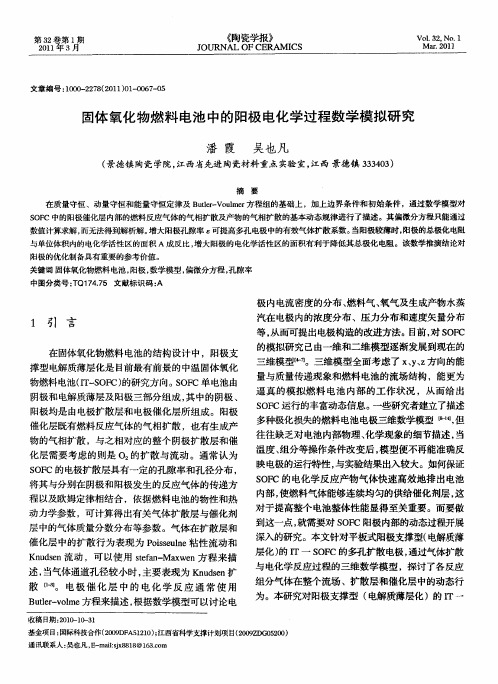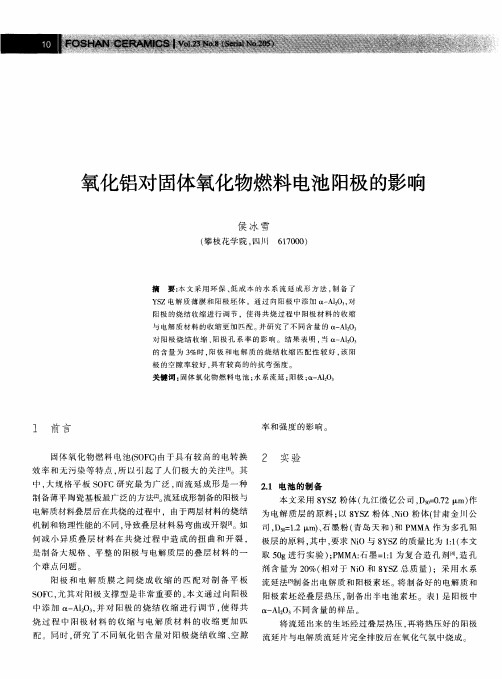Effect of alumina additions on the anodeelectrolyte interface in solid oxide fuel cells
- 格式:pdf
- 大小:1.09 MB
- 文档页数:9




第40卷㊀第7期2019年7月发㊀光㊀学㊀报CHINESEJOURNALOFLUMINESCENCEVol 40No 7Julyꎬ2019文章编号:1000 ̄7032(2019)07 ̄0915 ̄07界面处理对AlGaN/GaNMIS ̄HEMTs器件动态特性的影响韩㊀军1ꎬ赵佳豪1ꎬ赵㊀杰1ꎬ2ꎬ邢艳辉1∗ꎬ曹㊀旭1ꎬ付㊀凯2ꎬ宋㊀亮2ꎬ邓旭光2ꎬ张宝顺2(1.北京工业大学信息学部光电子技术省部共建教育部重点实验室ꎬ北京㊀100124ꎻ2.中国科学院苏州纳米技术与纳米仿生研究所纳米器件与应用重点实验室ꎬ江苏苏州㊀215123)摘要:研究不同界面处理对AlGaN/GaN金属 ̄绝缘层 ̄半导体(MIS)结构的高电子迁移率晶体管(HEMT)器件性能的影响ꎮ采用N2和NH3等离子体对器件界面预处理ꎬ实验结果表明ꎬN2等离子体预处理能够减小器件的电流崩塌ꎬ通过对N2等离子体预处理的时间优化ꎬ发现预处理时间10min能够较好地提高器件的动态特性ꎬ30min时动态性能下降ꎮ进一步引入AlN作为栅介质插入层并经过高温热退火后能够有效提高器件的动态性能ꎬ将器件的阈值回滞从411mV减小至111mVꎬ动态测试表明ꎬ在900V关态应力下ꎬ器件的电流崩塌因子从42.04减小至4.76ꎮ关㊀键㊀词:电流崩塌ꎻAlN栅介质插入层ꎻ界面处理ꎻAlGaN/GaN高电子迁移率晶体管中图分类号:TN386.2㊀㊀㊀文献标识码:A㊀㊀㊀DOI:10.3788/fgxb20194007.0915ImpactofInterfaceTreatmentonDynamicCharacteristicofAlGaN/GaNMIS ̄HEMTsHANJun1ꎬZHAOJia ̄hao1ꎬZHAOJie1ꎬ2ꎬXINGYan ̄hui1∗ꎬCAOXu1ꎬFUKai2ꎬSONGLiang2ꎬDENGXu ̄guang2ꎬZHANGBao ̄shun2(1.KeyLaboratoryofOpto ̄electronicsTechnologyꎬMinistryofEducationꎬBeijingUniversityofTechnologyꎬBeijing100124ꎬChinaꎻ2.KeyLaboratoryofNanoDevicesandApplicationsꎬSuzhouInstituteofNano ̄techandNano ̄bionicsꎬChineseAcademyofSciencesꎬSuzhou215123ꎬChina)∗CorrespondingAuthorꎬE ̄mail:xingyanhui@bjut.edu.cnAbstract:TheeffectsofdifferentkindsofinterfacetreatmentonthecharacteristicofAlGaN/GaNMIS ̄HEMTswerestudiedinthispaper.N2andNH3plasmapretreatmentwereusedtoimprovetheinterfacequality.TheresultsshowthatN2plasmapretreatmentcouldreducethecurrentcollapseofdevices.ByoptimizingthetimeofN2plasmapretreatmentꎬitwasfoundthatthedynamiccharacteristicofdeviceswith10minthepretreatmentwasimprovedꎬwhilethatof30minwasdegraded.Asagatedielectricin ̄tercalationlayerꎬtheannealedAlNinterlayercaneffectivelyimprovethedynamiccharacteristicofthedevice.TheVthhysteresiswasdecreasedfrom411mVto111mVꎬandthedevicecurrentcollapsefactorwasreducedfrom42.04to4.76afterunderOFF ̄stateVDstressof900.Keywords:currentcollapseꎻAlNgatedielectricinsertionlayerꎻinterfacetreatmentꎻAlGaN/GaNhighelectronmobilitytransistors㊀㊀收稿日期:2018 ̄08 ̄20ꎻ修订日期:2018 ̄10 ̄17㊀㊀基金项目:国家自然科学基金(61204011ꎬ11204009ꎬ61574011)ꎻ北京市自然科学基金(4142005ꎬ4182014)ꎻ北京市教委科学研究基金(PXM2018_014204_500020)资助项目SupportedbyNationalNaturalScienceFoundationofChina(61204011ꎬ11204009ꎬ61574011)ꎻBeijingNaturalScienceFounda ̄tion(4142005ꎬ4182014)ꎻBeijingMunicipalEducationCommissionScientificResearchFund(PXM2018_014204_500020)916㊀发㊀㊀光㊀㊀学㊀㊀报第40卷1㊀引㊀㊀言GaN作为第三代半导体的代表ꎬ具有高禁带宽度㊁高击穿电场㊁高电子迁移率㊁以及耐酸碱等特点ꎮ以AlGaN和GaN异质结结构制备的高电子迁移率晶体管ꎬ由于极化效应产生的天然的高浓度㊁高迁移率的二维电子气ꎬ在功率开关器件的大功率及高频性能方面有很好的应用前景[1 ̄4]ꎮMIS ̄HEMT器件可以有效地减小器件的栅极漏电ꎬ提高耐压ꎬ提高栅驱动能力ꎮ但是由于栅介质的引入ꎬ产生新的界面ꎬ界面质量给器件的应用带来新的问题ꎬ影响器件的可靠性和阈值回滞等ꎮEller等[5]详细报道了对于GaN表面的处理过程ꎬ包括湿法化学处理[6]㊁真空退火处理[7]㊁气体氛围下退火处理[8]及离子束㊁等离子体处理[9 ̄10]等ꎮGaN材料表面存在含O的化合物和N空位[2ꎬ11]ꎬ这两种缺陷态成为影响界面质量的主要因素ꎬ目前的报道中ꎬ集中于使用含N等离子体来处理器件表面[12 ̄14]ꎬ主要作用机理为去除O杂质和补充N空位ꎮHashizume[15]在器件钝化作用前使用N2作为等离子体处理样品表面ꎬ得到了很高质量的钝化结果ꎬ而且界面态浓度下降ꎮRomero[16]通过原位含氮气等离子体预处理ꎬ器件的电流崩塌㊁输出功率㊁增益等特性取得了非常好的效果ꎮ在本文研究中ꎬ我们对AlGaN/GaNMIS ̄HEMT器件工艺过程中的界面处理进行优化比较ꎬ实验利用等离子体预处理研究不同气体(N2和NH3)及不同预处理时间对器件直流性能和动态特性的影响ꎬ并在该研究基础上ꎬ继续引入AlN栅介质插入层进行界面处理ꎬ研究采用AlN栅介质插入层进行界面处理对器件动静态特性的影响ꎮ2㊀实㊀㊀验AlGaN/GaNHEMT外延材料是通过金属有机物化学气相沉积技术在Si(111)衬底上生长的ꎬ外延结构依次为成核层㊁GaN缓冲层和AlGaN势垒层ꎮ器件的制备工艺过程为:(1)界面处理过程ꎻ(2)栅介质钝化层制备ꎬ采用LPCVD沉积SiNx作为栅介质ꎬ主要考虑其具有良好的稳定性和漏电[7]ꎬ利用SiH2Cl2和NH3作为Si源和N源ꎬ温度780ħꎻ(3)注入隔离ꎬ采用F离子进行注入隔离ꎻ(4)欧姆接触制备ꎬ利用磁中性环路放电刻蚀SiNx形成窗口ꎬ电子束蒸发沉积Ti/Al/Ni/Au为20/130/50/50nmꎬN2氛围下850ħ退火30s形成欧姆接触ꎻ(5)栅电极制备ꎬ利用金属热蒸发沉积Ni/Au为50/10nm制备栅电极ꎮ图1(a)显示的是AlGaN/GaNMIS ̄HEMT器件基本结构示意图ꎬ器件栅介质层厚度为20nmꎬ器件栅长为2μmꎬ栅宽为100μmꎬ栅漏距离为16μmꎬ栅源距离为4μmꎮ其中对于界面处理工艺过程ꎬ设计了实验Ⅰ:采用不同预处理气体N2和NH3对AlGaN/GaNHEMT表面预处理ꎬ预处理时间均为5minꎬ实验分别设置为样品A和样品Bꎮ在实验I基础上设计实验方案Ⅱ:选取N2作为预处理气体ꎬ研究不同预处理时间对AlGaN/GaNMIS ̄HEMT器件的影响ꎬ设置样品C㊁D㊁E分别预处理的时间为0ꎬ10ꎬ30minꎮ上述等离子体预处理温度为350ħꎬ压强为266Pa(2000mtorr)ꎬRF功率为60WꎬLF功率为50WꎮSiN x2DEGAlGaNSiBufferSGAlN2DEGAlGaNSiN xSiBufferSGDD(a)(b)图1㊀(a)实验器件基本结构示意图ꎻ(b)引入插入层后的器件结构示意图ꎮFig.1㊀(a)Schematicofdevicesfordifferentpre ̄treatment.(b)Schematicofdevicestructureforsamplewithin ̄sertionlayer.为进一步改善AlGaN/GaNMIS ̄HEMT器件性能ꎬ在上述实验的基础上ꎬ设计实验Ⅲ:采取PEALD生长的AlN作为栅介质插入层ꎬ设置样品F㊁G㊁Hꎬ引入AlN插入层的器件结构示意图为图1(b)ꎮ样品F作为空白对照组未引入插入层界面处理过程ꎬ样品G和样品H利用PEALD生长3nmAlNꎬTMAl为Al源ꎬN2为N源ꎬ生长温度300ħꎮ样品H在栅介质沉积后于N2氛围下1000ħ退火2minꎮ样品栅介质LPCVD ̄SiNx12nmꎮ器件尺寸分别为:栅长2μmꎬ栅宽100μmꎬ栅漏距离30μmꎬ栅源距离3μmꎮ每组实验均采用安捷伦B1505A进行测试表征ꎮ㊀第7期韩㊀军ꎬ等:界面处理对AlGaN/GaNMIS ̄HEMTs器件动态特性的影响917㊀3㊀结果与讨论3.1㊀界面预处理气体的影响图2是N2和NH3预处理器件的转移输出曲线ꎬ从图2中可以看出不同的预处理气体对器件的直流特性具有明显的影响ꎮN2和NH3等离子体预处理之后器件的峰值跨导分别是64.6mS/mm和70.7mS/mmꎬ饱和电流分别为579.3mA/mm和550mA/mmꎮN2等离子体预处理的器件跨导峰值较NH3等离子体预处理器件低ꎬ但是饱和电流有所增加ꎮ在图2中还看到ꎬ相比于N2等离子体预处理ꎬNH3等离子体预处理的实验结果中存在饱和电流下降的现象ꎬ这与Kim[12]报道的一致ꎬ究其原因是在NH3在较低功率下产生等离子体的同时会产生一个H+的钝化效果ꎮ类似的钝化对于器件的RF性能会有所提升ꎬ但对器件的DC特性有退化ꎬHashizume[17]和Romero[16]的研究已经证明了这一点ꎮ为了进一步对比采用N2和NH3不同预处理气体对表面态引起的器件性能退化作用ꎬ实验对样品A和样品B进行了电流崩塌的表征ꎮ图3分别显示了关态下漏极电压600500-20V GS /VI D /(m A ·m m -1)4003002001000N 2plasmaNH 3plasma(a )-15-10-55406080200G m /(m S ·m m -1)6005002V d /VI D /(m A ·m m -1)4003002001000N 2plasma NH 3plasma(b )461012143V -3V -5V -7V -9V80V GS -15~3V 图2㊀N2和NH3等离子体预处输出曲线理器件转移输出曲线对比ꎮ(a)转移曲线ꎻ(b)输出曲线ꎮFig.2㊀TtransferandoutputcurvesforsampleAwithN2plasmaandsampleBwithNH3plasma.(a)Trans ̄fercurves.(b)Outputcurves.10080300V d /VR D y n a m i c /R O N20010100506040200N 2plasma NH 3plasmaOFF 鄄state:V GS =-15VOFF 鄄ON swtiching time:t =200滋s ON 鄄state:V GS =0V V D =1V图3㊀N2和NH3等离子体预处理器件电流崩塌对比Fig.3㊀CurrentcollapseforsampleAwithN2plasmaandsampleBwithNH3plasma10ꎬ50ꎬ100ꎬ200ꎬ300V下的电流崩塌ꎮ从图3中可以看到在不同的漏极偏压下ꎬN2等离子体预处理器件的电流崩塌因子明显较NH3等离子体预处理的小ꎬN2等离子体预处理器件在偏压100V时崩塌因子最大值为35.6ꎬNH3等离子体预处理器件为57.5ꎻ在偏压300V时ꎬNH3等离子体预处理器件的崩塌因子最大值为85.3ꎬN2等离子体预处理器件为19.1ꎮ对比器件的动静态性能ꎬ采用N2等离子体预处理能够有效地提高器件的动态性能ꎮ3.2㊀界面预处理时间的影响图4给出了不同预处理时间下ꎬ器件转移输出特性对比ꎮ结果显示不同预处理时间对样品的基本电学性能影响不明显ꎬ预处理后器件的静态性能没有大的提高ꎮ采用pulse ̄DC表征器件的动态性能ꎮ器件测试脉冲是(5msꎬ3ms)ꎬ即关态偏压施加的时间是3msꎬ测试周期是5msꎬ器件关态偏压为(VD:50VꎬVGS:-20V)ꎮ图5中展示了不同时间预处理器件的直流/脉冲输出电流曲线对比ꎮ相比于静态输出电流ꎬC㊁D㊁E样品的脉冲输出电流都发生了明显下降ꎬ其中未经过N2等离子体预处理的样品C下降最为严重ꎬ预处理时间10min的样品D结果最好ꎬ样品C㊁D及样品E的饱和电流下降幅度分别为306.1ꎬ99.1ꎬ184.5mA/mmꎮ该结果表明利用N2等离子体预处理能够明显地减小器件界面导致的性能退化ꎮ对比预处理10min的样品D和处理30min的样品E的结果ꎬ发现长时间的预处理对器件的性能有一定的损害ꎬ主要原因是长时间的预处理导致表面有正电荷或者新的施主态的积累ꎬ使得器件动态性能下降[18]ꎮ918㊀发㊀㊀光㊀㊀学㊀㊀报第40卷V GS /V600500-15I D /(m A ·m m -1)400300200CD E 1000-20-10-505V d :10V20406080G m /(m S ·m m -1)(a )V D /V6005004I D /(m A ·m m -1)400300200C D E100001081214V GS (b )-14~2V 622V -2V-6V-10V 图4㊀不同预处理时间下器件转移输出特性曲线ꎮ(a)转移曲线ꎻ(b)输出曲线ꎮFig.4㊀Transferandoutputcurvesforthreesamples.(a)Transfercurves.(b)Outputcurves.6005002V D /VI D /(m A ·m m -1)(a )Pulse:(5ms,3ms)Based:(V d ,V gs )(50V,-20V)DC:V g :-14~2V step:4V V d :0~10VDCPulse40030020010000468101214166005002V D /VI D /(m A ·m m -1)(b )Pulse:(5ms,3ms)Based:(V d ,V gs )(50V,-20V)DC:V gs :-14~2V step:4V V d :0~10VDC Pulse40030020010000468101214166005002V D /VI D /(m A ·m m -1)(c )Pulse:(5ms,3ms)Based:(V d ,V gs )(50V,-20V)DC:V gs :-14~2V step:4V V d :0~10VDC Pulse 4003002001000046810121416600500CV D /VI D /(m A ·m m -1)(d )400300D E200DCPulse100图5㊀直流㊁脉冲输出曲线对比ꎮ(a)样品Cꎻ(b)样品Dꎻ(c)样品Eꎻ(d)实验样品直流/脉冲下饱和电流对比ꎮFig.5㊀ComparisionofpulsedI ̄Vcharacteristics.(a)SampleC.(b)SampleD.(c)SampleE.(d)ComparisonofsaturationoutputcurrentdensitybetweenpulsedandDC.3.3㊀界面栅介质插入层的影响图6展示了器件的转移输出特性对比ꎮ为了更明显地显示ꎬ将样品F㊁G的对比结果显示于图6(a)㊁(b)ꎬ将样品G㊁H的对比结果显示于图6(c)㊁(d)ꎮ样品F㊁G和H阈值电压分别为-6.46ꎬ-7.62ꎬ-7.04Vꎬ由此看出采用AlN栅介质插入层导致了器件的阈值向负漂移ꎬ是因为引入AlN插入层会在表面形成极化正电荷ꎬ影响阈值电压ꎮ图6中给出了样品F㊁G和H导通电阻分别为13.8ꎬ15.7ꎬ20.6Ω mmꎮ和样品F比较ꎬ样品G和H导通电阻增加的原因可能是引入AlN介质插入层会造成导通电阻在一定范围内退化ꎬ从而使饱和电流下降[19 ̄20]ꎮ观察图6(c)ꎬ发现样品H中ꎬ从-15V扫到5V的正向及从5V回扫到-15V的转移曲线回滞明显消除ꎬ而没有高温退火的样品G中回滞现象明显ꎮ图7给出了实验样品的正向阈值与负向阈值的对比ꎬ器件的阈值在回扫过程中会出现正向漂移ꎬF㊁G和H器件的阈值回滞ΔVth(Vth负向-Vth正向)分别为411ꎬ506ꎬ111mVꎮ和样品F相比ꎬ样品H的ΔVth降低72.99%ꎬ可以看出采用退火后AlN栅介质插入层界面处理的器件阈值回滞明显消除ꎬ说明由界面引起的器件性能退化得到控制ꎮ另外ꎬ未经过退火的AlN介质插入层的界面处理的器件G㊀第7期韩㊀军ꎬ等:界面处理对AlGaN/GaNMIS ̄HEMTs器件动态特性的影响919㊀阈值回滞反而增大ꎬ这可能是AlN材料中存在缺陷导致的ꎮ经过1000ħ的退火过程的样品HꎬAlN材料存在重结晶过程ꎬ提高了AlN材料质量ꎬ改善了界面质量ꎮ400-15V GS /VI D /(m A ·m m -1)(a )30020010006Reference(F)AlN interlaye(G)V GS :-15~5VV D :15~-15V V D :10V-12-9-6-303200406080Gm /(m S ·m m -1)400V D /VI D /(m A ·m m -1)(b )3002001000Reference(F)AlN interlaye(G)246810R ON (F)=13.8赘·mm R ON (G)=15.7赘·mm400-15V GS /VI D /(m A ·m m -1)(c )30020010006Anneal(H)AlN interlaye(G)V GS :15~5V V GS :15~-15V V D :10V-12-9-6-303200406080Gm /(m S ·m m -1)400V D /VI D /(m A ·m m -1)(d )3002001000AlN interlayer anneal(H)AlN interlaye(G)246810R ON (G)=15.7赘·mm R ON (G)=20.6赘·mmAlN interlayer(G)图6㊀样品转移㊁输出特性曲线对比ꎮ(a㊁b)样品F㊁G对比ꎻ(c㊁d)样品G㊁H对比ꎮFig.6㊀Comparisonoftransferandoutputcurvesforsamples.(aꎬb)SampleFandsampleG.(cꎬd)SampleGandsampleH.-6.2FV t h /VGH506mV111mVV GS :-15~5V V GS :5~-15V411mV -6.0-6.4-6.6-6.8-7.0-7.2-7.4-7.6图7㊀样品F㊁G㊁H正回扫阈值回滞对比ꎮFig.7㊀VthhysteresisforsampleFꎬsampleGandsampleH.图8给出了样品F㊁G㊁H电流崩塌对比ꎮ对比样品F和G数据ꎬ可以看出未经过退火处理的AlN插入层对器件的电流崩塌的改善不明显ꎬ这一结论同图7中器件阈值回滞变化相一致ꎮ对比样品G与H可以看出ꎬ器件的电流崩塌得到了很好的提高ꎬ900V下电流崩塌因子由样品G中的42.04下降到样品H的4.76ꎬ抑制效果明显ꎮ因此利用退火AlN作为栅介质插入层进行界面处理ꎬ能够有效改善Al ̄GaN/GaNMIS ̄HEMT器件界面ꎬ提高界面质量ꎬ抑制电流崩塌ꎬ提高器件可靠性ꎮQuiesent drain bias/V80R D y n a m i c /R O N40080010060402002006001000AlN interlayer anneal(H)AlN interlayer(G)Reference(F)图8㊀样品F㊁G㊁H电流崩塌对比ꎮFig.8㊀CurrentcollapseforsampleFꎬsampleGandsampleH.4㊀结㊀㊀论本文研究了AlGaN/GaNMIS ̄HEMT器件制备过程中不同界面处理对其性能的影响ꎮ研究发现ꎬ经过N2等离子体预处理较NH3等离子体预处理能够降低器件的电流崩塌因子ꎬ提高器件的可靠性ꎬ在该研究基础上优化了N2等离子体预处理时间ꎬ实验结果显示10min等离子体预处理能920㊀发㊀㊀光㊀㊀学㊀㊀报第40卷够有效地提高器件脉冲下电流ꎮ进一步引入AlN栅介质插入层ꎬ实验发现利用AlN插入层及退火工艺能够有效地改善AlGaN/GaNMIS ̄HEMT器件界面质量ꎬ抑制电流崩塌ꎬ提高器件可靠性ꎬ器件的阈值回滞从411mV减小至111mVꎬ实现在关态应力900V下将器件的电流崩塌因子由42.04下降到4.76ꎮ参㊀考㊀文㊀献:[1]ZHANGZLꎬYUGHꎬZHANGXDꎬetal..Studiesonhigh ̄voltageGaN ̄on ̄SiMIS ̄HEMTsusingLPCVDSi3N4asgatedielectricandpassivationlayer[J].IEEETrans.ElectronDev.ꎬ2016ꎬ63(2):731 ̄738.[2]LIUSCꎬCHENBYꎬLINYCꎬetal..GaNMIS ̄HEMTswithnitrogenpassivationforpowerdeviceapplications[J].IEEEElectronDev.Lett.ꎬ2014ꎬ35(10):1001 ̄1003.[3]KELEKÇIÖꎬTAŞLIPTꎬYUHBꎬetal..ElectrontransportpropertiesinAl0.25Ga0.75N/AlN/GaNheterostructureswithdifferentInGaNbackbarrierlayersandGaNchannelthicknessesgrownbyMOCVD[J].Phys.StatusSolidiꎬ2012ꎬ209(3):434 ̄438.[4]王凯ꎬ邢艳辉ꎬ韩军ꎬ等.掺Fe高阻GaN缓冲层特性及其对AlGaN/GaN高电子迁移率晶体管器件的影响研究[J].物理学报ꎬ2016ꎬ65(1):016802 ̄1 ̄6.WANGKꎬXINGYHꎬHANJꎬetal..GrowthsofFe ̄dopedGaNhigh ̄resistivitybufferlayersforAlGaN/GaNhighelectronmobilitytransistordevices[J].ActaPhys.Sinicaꎬ2016ꎬ65(1):016802 ̄1 ̄6.(inChinese)[5]ELLERBSꎬYANGJLꎬNEMANICHRJ.ElectronicsurfaceanddielectricinterfacestatesonGaNandAlGaN[J].J.Vac.Sci.Technol.Aꎬ2013ꎬ31(5):050807 ̄1 ̄29.[6]XIONGCꎬLIUSHꎬLIYHꎬetal..Hotcarriereffectonthebipolartransistors responsetoelectromagneticinterference[J].Microelectr.Reliabil.ꎬ2015ꎬ55(3 ̄4):514 ̄519.[7]ZHANGZLꎬFUKꎬDENGXGꎬetal..NormallyoffAlGaN/GaNMIS ̄high ̄electronmobilitytransistorsfabricatedbyusinglowpressurechemicalvapordepositionSi3N4gatedielectricandstandardfluorineionimplantation[J].IEEEElectronDev.Lett.ꎬ2015ꎬ36(11):1128 ̄1131.[8]PENGMZꎬZHENGYKꎬWEIKꎬetal..Post ̄processthermaltreatmentformicrowavepowerimprovementofAlGaN/GaNHEMTs[J].Microelectr.Eng.ꎬ2010ꎬ87(12):2638 ̄2641.[9]VANKOGꎬLALINSKY'TꎬHAŠC㊅ÍKSꎬetal..ImpactofSF6plasmatreatmentonperformanceofAlGaN/GaNHEMT[J].Vacuumꎬ2009ꎬ84(1):235 ̄237.[10]MEYERDJꎬFLEMISHJRꎬREDWINGJM.SF6/O2plasmaeffectsonsiliconnitridepassivationofAlGaN/GaNhighelectronmobilitytransistors[J].Appl.Phys.Lett.ꎬ2006ꎬ89(22):223523 ̄1 ̄3.[11]WATANABETꎬTERAMOTOAꎬNAKAOYꎬetal..Low ̄interface ̄trap ̄densityandhigh ̄breakdown ̄electric ̄fieldSiNFilmsonGaNformedbyplasmapretreatmentusingmicrowave ̄excitedplasma ̄enhancedchemicalvapordeposition[J].IEEETrans.ElectronDev.ꎬ2013ꎬ60(6):1916 ̄1922.[12]KIMJHꎬCHOIHGꎬHAMWꎬetal..Effectsofnitride ̄basedplasmapretreatmentpriortoSiNxPassivationinAlGaN/GaNhigh ̄electron ̄mobilitytransistorsonsiliconsubstrates[J].Jpn.J.Appl.Phys.ꎬ2010ꎬ49(4S):04DF05. [13]HUANGSꎬJIANGQMꎬYANGSꎬetal..EffectivepassivationofAlGaN/GaNHEMTsbyALD ̄grownAlNthinfilm[J].IEEEElectronDev.Lett.ꎬ2012ꎬ33(4):516 ̄518.[14]EDWARDSAPꎬMITTEREDERJAꎬBINARISCꎬetal..ImprovedreliabilityofAlGaN ̄GaNHEMTsusinganNH3/plas ̄matreatmentpriortoSiNpassivation[J].IEEEElectronDev.Lett.ꎬ2005ꎬ26(4):225 ̄227.[15]HASHIZUMETꎬOOTOMOSꎬOYAMASꎬetal..ChemistryandelectricalpropertiesofsurfacesofGaNandGaN/AlGaNheterostructures[J].J.Vac.Sci.Technol.ꎬ2001ꎬ19(4):1675 ̄1681.[16]ROMEROMFꎬJIMÉNEZJIMENEZAꎬMIGUEL ̄SÁNCHEZMIGUEL ̄SANCHEZJꎬetal..EffectsofN2plasmapretreat ̄mentontheSiNpassivationofAlGaN/GaNHEMT[J].IEEEElectronDev.Lett.ꎬ2008ꎬ29(3):209 ̄211.[17]HASHIZUMETꎬOOTOMOSꎬINAGAKITꎬetal..SurfacepassivationofGaNandGaN/AlGaNheterostructuresbydielec ̄tricfilmsanditsapplicationtoinsulated ̄gateheterostructuretransistors[J].J.Vac.Sci.Technol.Bꎬ2003ꎬ21(4):1828 ̄1838.㊀第7期韩㊀军ꎬ等:界面处理对AlGaN/GaNMIS ̄HEMTs器件动态特性的影响921㊀[18]REINERMꎬLAGGERPꎬPRECHTLGꎬetal..Modificationof native surfacedonorstatesinAlGaN/GaNMIS ̄HEMTsbyfluorination:perspectivefordefectengineering[C].ProceedingsofIEEEInternationalElectronDevicesMeetingꎬWash ̄ingtonꎬDCꎬUSAꎬ2015:35.5.1 ̄35.5.4.[19]ACURIOEꎬCRUPIFꎬMAGNONEPꎬetal..ImpactofAlNlayersandwichedbetweentheGaNandtheAl2O3layersontheperformanceandreliabilityofrecessedAlGaN/GaNMOS ̄HEMTs[J].Microelectr.Eng.ꎬ2017ꎬ178:42 ̄47.[20]HUANGSꎬJIANGQMꎬYANGSꎬetal..MechanismofPEALD ̄grownAlNpassivationforAlGaN/GaNHEMTs:compen ̄sationofinterfacetrapsbypolarizationcharges[J].IEEEElectronDev.Lett.ꎬ2013ꎬ34(2):193 ̄195.韩军(1964-)ꎬ男ꎬ北京人ꎬ博士ꎬ副教授ꎬ2008年于北京工业大学获得博士学位ꎬ主要从事半导体材料与器件方面的研究ꎮE ̄mail:hanjun@bjut.edu.cn邢艳辉(1974-)ꎬ女ꎬ吉林德惠人ꎬ博士ꎬ副教授ꎬ2008年于北京工业大学获得博士学位ꎬ主要从事氮化镓半导体材料的生长㊁测试分析及器件等方面的研究ꎮE ̄mail:xingyanhui@bjut.edu.cn。

第37卷第1期 (2021 年1月)福建师范大学学报(自然科学版)Journal of Fujian Normal University (Natural Science Edition)V ol.37,No. 1Jan. 2021DOI :10. 12046/j. issn. 1000-5277. 2021. 01. 003 文章编号:1000-5277(2021)01-0018-13无机固态电解质及其电极-电解质界面优化对全固态锂离子电池性能提高的研究进展李志宣,陈越,林洪斌,林春,潘汉殿,黄志高(福建师范大学物理与能源学院,福建省f l子调控与新能源材料重点实验室,福建福州350117)摘要:固态电池研究的重点在于开发高离子电导率的固态电解质,并优化固态电解质和电极的界面问题.首先以近年来受到广泛研究的无机固态电解质为中心,主要介绍通过固相烧结、液相烧结、溶胶凝胶法等方法制备的包括L iPO N型、钙钛矿型、石榴石型和NAS丨C O N型在内的4种无机固态电解质及其在全固态锂离子电池中的应用;其次,通过对固态电解质表面修饰及界面优化,并结合不同的修饰方法讨论了界面优化的本征机制;最后对固态电池的研究开发、应用及发展前景进行了展望.关键词:全固态锂离子电池;固态电解质;无机;界面中图分类号:0641 文献标志码:AResearch Progress on Inorganic Solid Electrolyte and Its Improvement of Interface Issue for All-solid-state Lithium BatteriesLI Zhixuan, CHEN Yue, LIN Hongbin, LIN Chun, PAN Handian, HUANG Zhigao (College o f Physics and Energy, Fujian Normal University,Fujian Provincial Key Laboratory ofQuantum Manipulation and New Energy Materials, Fuzhou350117, China)Abstract :The key issue for research of all-solid-state lithium-ion batteries is development of solid electrolytes with high ionic conductivities and improvement of interface issue between electrolyte and electrode. In this review, four types of solid electrolytes applied in all-solid-state lithium- ion batteries including LiPON-type, perovskite-type, garnet-type, NASICON-type were discussed, and various preparation methods including solid phase sintering, liquid phase sintering and sol-gel method were also reviewed. Additionally, the modification of electrolyte interface for solving interface issue was investigated, and the intrinsic mechanism of interface issue was discussed. At last, the future development and application on solid-state lithium batteries were proposed.Key words:all-solid-state lithium batteries;solid electrolyte;inorganic;interface.20世纪90年代初索尼公司发布的首个商业化锂离子电池推动了移动电子产品开始向轻量化、便 携式的方向发展.如今锂离子电池应用领域不断扩大,性能逐年提升.成熟的商业化锂电池采用的是 有机液态电解质,它虽然具有很高的离子电导率,但是在电池充放电过程中,特别是高温下容易与电 极发生界面副反应导致钝化膜的持续增长;而在低温或大电流充电下,金属锂容易在负极表面析出产 生锂枝晶会对电池寿命产生影响;同时由于液态电解质热稳定性低、燃点低等方面的缺陷可能引起电 池的燃烧爆炸等不容忽视的安全问题1:.为解决上述难题,科研人员将目光转向了使用固态电解质的 全固态锂电池,其相比于使用液态电解质的锂电池具有更高的安全性和能量密度,在电子产品、混合 动力汽车等领域拥有广阔的市场前景.固态电解质分为聚合物电解质和无机电解质,聚合物固态电解质的优势在于生产成本低廉,并且 在可穿戴柔性设备上具有应用前景,但也面临在室温下离子电导率低、机械强度和热力学稳定性较差收稿日期:2020-06-01基金项目:国家自然科学基金资助项目(61574037 , 21203025)通信作者:黄志高(1%4-),男,教授,博士,研究方向为先进材料设计和新能源材料.Z ghuang@.,.n第1期李志宣,等:无机固态电解质及其电极-电解质界面优化对全固态锂离子电池性能提高的研究进展 19以及电化学窗口窄等问题2].无机固态电解质所具有的高离子电导率、电化学和热力学性能的稳定、优秀的机械性能和不易燃等特点使它在作为电解质时能够平衡电池的使用性能同时保障安全性.早期对固态电解质的开发在于寻找高离子电导率、低电子电导率及合适电化学窗口的离子导体材料3].这些关键性能参数在近几年的研究开发中得到了大幅提升,但同时固态电解质的实际应用发展又面临新—高的界面阻抗14].与传统有机液态电解质与电极良好的接触性不同的是,固态电解质虽然 的挑战—已经具有很高的离子电导率,但由于固态电解质和电极的固/固界面接触性较差使得界面阻抗大大增加,阻碍离子传输和电池的容M释放5i.因此,近年来全固态电池的研究方向一方面在于探索制备更 高离子电导率电解质,另一方面在于通过各种方法修饰固态电解质和电极的接触界面以优化界面,降 低阻抗,提高电池性能.本文将介绍近年来全固态锂离子电池所选用的电解质及其合成方法,并综述 了优化固态电解质界面问题的最新进展.1无机固态电解质近年来,无机化合物由于其高的离子电导率成为热门锂电池电解质研究材料.目前开发的无机固态电解质材料可分为氧化物型和硫化物型.硫化物固态电解质由于和金属锂的化学亲和力较弱f6],锂离子在硫化物内的流动性更强使它具有超高的离子电导率.硫化物固态电解质主要为LISICON型,其 化学式为 Li.I V^M'S,(M 为 Si、Ge,M'为P、A l、Zii、Ga、Sb),它们为7-Li3P04 结构;还有 Li2S-P2S5.且认为硫化物电解质Li2S-P2S5和L1SIC0N型固态电解质Li4_,Ge h P tS4(0 < x < 1)具有好的发 展前景7:.Yoshikatsu等[8]制备出一种Li2S-P2S5玻璃陶瓷,在室温下离子电导率达到了 1.7x l(T2S . cm'2011年,Norilu等[9:使用真空烧结的方法制备出了新型的固态电解质I」丨〇GeP2S12,在室温下离 子电导率达到了 1.2x l(T2S •cm'虽然硫化物固态电解质超高的离子电导率甚至超过了许多液态电 解质,但硫化物电解质在接触到空气后会和空气中的水发生反应产生有毒气体H2S,在影响电池稳定 性的同时也会造成安全隐患和环境污染问题.与之相比,无机氧化物电解质在化学稳定性和热稳定性 上的优势可以很好地解决人们对锂离子电池高能量密度的需求和电池使用安全问题之间的矛盾.随着 研究不断深人,新开发的无机氧化物电解质种类繁多,以下将主要综述广泛使用的石榴石型、LiPON 型、钙钛矿型和NASIC0N型4种类型的无机氧化物固态电解质.1.1石榴石墦石榴石型的固态电解质在1969年被首次报道11(1,化学通式为:Li3+,A,B2012,石榴石固态电解质 的结构分为四方相和立方相,锂原子可分别占据八面体Zr06和十二面体LaOs配位,其中立方相为离 子电导率更高的高温稳定相.Tliangadurai等11在2003年首次发现『新型石溜石结构的锂离子导体Li5La3M2012(M = Nb,Ta),并且之后在高温下采用传统的固态反应法成功制备出离子电导率达到0. 1~ 1.0 mS •的石榴 石型固态电解质Li7La,Zr2012(LLZ0).相比于上文提到的硫化物固态电解质,石榴石型固态电解质 具备更好的安全性和热稳定性[121.为了提高石榴石型电解质的电导率,在制备过程中掺人元素是一 种有效的办法.Xiang等'13制备了 LiwA^La^Zi^O^ (A= Be、B、Al、Fe、Z n和Ga),其中掺人兀素 的比例0.2~0. 3.根据电化学阻抗谱的测量结果,发现A1、F e和G a掺杂的LLZ0样品具有更高的离 子电导率,其中G a掺杂的样品在室温下的电导率达到了 1.31x l〇-3S .cm'同时结合XRD物相分析 发现,通过Al、F e和G a元素的掺杂实现了对L i元素的替代,使得掺杂后的LLZ0样品中具有更高离 子电导率的立方相更加稳定,从而提高了样品的离子电导率.243»等[|4]使用固相反应法制备了 A1掺 杂的LLZ0样品.样品化学式为:Li7_,Al,La3Zr2012,A1的掺杂量控制在0~0.25之间.如图l(a)(b)所示的乂1^测量结果表明,在丨」7_,丨>1^為20|:样品中的四方相和立方相的含量随着人1掺杂量的变 化而变化,当掺人0.1 mol的A1时,样品中四方相的信号几乎消失而表现出纯的立方相.结合对一系 列不同含量的样品的阻抗谱分析(如图I(c)所示),并通过计算得出掺量为0.1 mol的样品具有最大的 离子电导率,在30 t下达到了 L41x l〇_4S •o ir1,这与之前XRD的测试中立方相含量最高的结果相吻合.20福建师范大学学报(自然科学版)2021 年-20.-0 mol A1 0.05 mol A1 0.10 mol A1 0.20 mol A i3026/(°)40图1(a) (b) Al-LLZO样品的X射线衍射图谱,(c)在30尤下0〜0.25 mo丨含量范围内A1元素掺杂LLZO样品的电化学阻抗谱[|4]Fig. 1( a) ( b) X-ray diffraction patterns of Al-LLZO samples,( c) Nyquist plots for the totalionic conductivity of LLZO samples with 0 〜0. 25 mol Al doping at 30 Ti 14■等[15]则使用Li2C03、Rb2C03、La203、21〇2和〇320,粉末,通过固相反应的方法制得了 Ga、汕元素掺杂的1^62。

纳米锂镧锆钽氧粉体复合聚氧化乙烯制备的固态电解质电化学性能的研究赵宁;李忆秋;张静娴;狄增峰;郭向欣【摘要】与采用液体电解液的传统二次锂离子电池相比,固态二次锂电池在高能量密度和安全性方面具有显著的潜在优势,近年来成为国内外的研究热点.作为固态二次锂电池的核心组成,固态电解质需要具备高离子电导率、宽电化学窗口、对锂稳定、力学性能优以及可抑制锂枝晶等特性.为达到以上要求,本工作探索制备了由纳米钽掺杂锂镧锆氧(LLZTO)粉体与聚氧化乙烯(PEO)复合的有机-无机复合固态电解质膜材料,对比研究了在有机物PEO中添加锂盐和不添加锂盐对固态电解质膜电导率及电化学特性的影响.发现在PEO-LLZTO复合电解质膜中,虽然PEO不导电,但界面处存在的渗流效应可极大提高膜的总电导率,室温离子电导率可达到2×10-4 S/cm.这一数值虽然略低于PEO-LiTFSI-LLZTO复合电解质膜(室温条件下电导率为6×10-4 S/cm),但无锂盐添加的PEO-LLZTO复合电解质膜表现出较好的电化学稳定性和较强的抑制锂枝晶的能力.将PEO-LLZTO复合电解质膜与Li/LiFePO4和Li/LiFe0.15Mn0.85PO4组装成软包电池,在0.1C、60℃的测试条件下可充分发挥正极材料的容量,并可稳定循环200次以上.【期刊名称】《储能科学与技术》【年(卷),期】2016(005)005【总页数】8页(P754-761)【关键词】固态电解质;聚氧化乙烯;LLZTO纳米粉;渗流效应【作者】赵宁;李忆秋;张静娴;狄增峰;郭向欣【作者单位】中国科学院上海硅酸盐研究所,上海200050;中国科学院上海硅酸盐研究所,上海200050;中国科学院上海微系统与信息技术研究所,上海200050;中国科学院上海微系统与信息技术研究所,上海200050;中国科学院上海硅酸盐研究所,上海200050【正文语种】中文【中图分类】TM911固态二次锂电池是采用固态电解质、复合负极或金属锂负极、复合正极的一种可充电电池,它的基本构型如图1所示。
第53卷第3期2021年3月Vol.53No.3Mar.,2021无机盐工业INORGANIC CHEMICALS INDUSTRY催化材料Doi:10.11962/1006-4990.2020-0232开放科学(资源服务)标志识码(OSID)微反应器水热法耦合制备纳米片状氧化铝王梦迪“,罗瑾周靖辉",于海斌吴巍",李晓云"(1.中海油天津化工研究设计院有限公司,天津300131;2.天津市炼化催化技术工程中心)摘要:以偏铝酸钠和硫酸铝为原料,通过一种高通量撞击流微反应器,提岀了将微反应法与老化、水热法高效集成制备纳米片状氧化铝的新工艺。
利用X射线衍射(XRD)、扫描电镜(SEM)、透射电镜(TEM)、BET法比表面积测定(BET)、热重-差热分析(TG-DTG)等方式对不同工艺耦合制备的产物进行了测试分析,研究了不同耦合方式对产物晶型、形貌、介孔结构等物理性质的影响。
结果表明:通过微反应器-水热法耦合技术能够制备粒径为30~100nm、厚度为2~5nm、纯度为99.7%以上的纳米片层状勃姆石(酌-AlOOH),经550益焙烧4h可制得同样形貌的酌-氧化铝(酌-Al J O i)。
通过不同工艺耦合能够调控氧化铝的形貌、介孔结构,为工业化制备片层状纳米氧化铝提供了很好的科研支撑。
关键词:高通量;微反应;水热;纳米片状氧化铝中图分类号:TQ131.1文献标识码:A文章编号:1006-4990(2021)03-0087-06Microreactor-hydrothermal coupling preparation of nano-flaky aluminaWang Mengdi1,2,Luo Jin1袁Zhou Jinghui1,2,Yu Haibin1,Wu Wei1,2,Li Xiaoyun1,2(1.CenerTech Tianjin Chemical Research and Design Institute Co.,Ltd.,Tianjin300131,China;2.Tianjin Refining Catalytic Technology Engineering Center)Abstract: A novel preparation process of nano-flaky alumina is proposed by using a high-throughput impinging stream microreactor with sodium metaaluminate and aluminum sulfate as raw materials,which efficiently integrates the micro-reaction method with aging and hydrothermal method.The effect of different coupling methods on the physical properties of the product such as crystal shape,morphology and pore structure was studied by XRD,SEM,TEM,BET,TG-DTG and other test methods.The flaky酌-AlOOH with purity of more than99.7%,particle size of30~100nm and thickness of2~5nm can be produced by microreaction-hydrothermal coupling technology.The酌-Al2O3with the same morphology can be obtained after calcination at550益for4h.The morphology and mesoporous structure of alumina powder can be regulated by the coupling of different processes.It provides theoretical support for the industrial production of nano-flaky alumina.Key words:high-throughput;microreaction;hydrothermal;nano-flaky alumina纳米氧化铝因具有优异的机械和化学性能,被广泛用于催化剂、复合增强材料、陶瓷材料、生物医学材料、半导体材料等。
[1] Abbas Afkhami, Hasan Bagheri, Tayyebeh Madrakian, Alumina nanoparticles grafted with functional groups as a new adsorbent in efficient removal of formaldehyde from water samples, Desalination 281 (2011) 151–158.[2] Haibao Huang,Dennis Y. C. Leung and Daiqi Ye,Effect of reduction treatment on structural properties of TiO2supported Pt nanoparticles and their catalytic activity for formaldehyde oxidation, Journal of Materials Chemistry J. Mater. Chem. 2011 /21/ 9647.[3] YOSHIO NAKANOM, KENJI TAKESHITA and TOSHIRO TSUTSUMI,ADSORPTION MECHANISMOF HEXA V ALENT CHROMIUMBY REDOX WITHIN CONDENSED-TANNIN GEL,Wat. Res. V ol. 35, No. 2, pp. 496±500, 2001.[3] A. Hayashi ,Y. Fujimoto, Y. Ogawa, H. Nakayama, M. Tsuhako,Adsorption of gaseous formaldehyde and carboxylic acids by ammonium-ion-exchanged α-zirconium phosphate , Journal of Colloid and Interface Science 283 (2005) 57–63.[4]Kyung Jin Lee a, Nanako Shiratorib, Gang Ho Lee b, Jin Miyawakib, Isao Mochida b,Seong-Ho Yoon b, Jyongsik Jang a,Activated carbon nanofib er produced from electrospun polyacrylonitrile nanofiber as a highly efficient formaldehyde adsorbent, CARBON 48 (2010) 4248 – 4255.[5] Wang Xiaoyan, Wang Huixiang*, Wang Shaoli,Ambient formaldehyde and its contr and OH radical in a rural area, Atmospheric Environment 44 (2010) 2074e2078.[6] Adrian M. T. Silvaa Isabel M. Castelo-Brancoa, Rosa M. Quinta-Ferreiraa, Janez Levec,Catalytic studies in wet oxidation of e%uents from formaldehyde industry, Chemical Engineering Science 58 (2003) 963 – 970.[7] Haiqin Rong , Zhenyu Ryu , Jingtang Zheng , Yuanli Zhang,Effect of air oxidation of Rayon-based activated carbon fibers on the adsorption behavior for formaldehyde, Carbon 40 (2002) 2291–2300.[8] A. Karantonis , D. Koutsaftis, N. Kouloumbi, Bistability, oscillations and bifurcations of the electrocatalytic oxidation of HCHO on Pt, Chemical Physics Letters 422 (2006) 78–82.[9]LI Jing , LI Zhong , LIU Bing , XIA Qibin and XI Hongxia, Effect of Relative Humidity on Adsorption of Formaldehyde on Modified Activated Carbons, Chinese Journal of Chemical Engineering, 16(6) 871ü875 (2008).[10] R.B. de Lima, M.P. Massafera, E.A. Batista, T. Iwasita, Catalysis of formaldehyde oxidation by electrodeposits of PtRu, Journal of Electroanalytical Chemistry 603 (2007) 142–148.[11] Afsaneh Safavi , Norouz Maleki, Fatemeh Farjami, Elaheh Farjami, Electrocatalytic oxidation of formaldehyde on palladium nanoparticles electrodeposited on carbon ionic liquid composite electrode, Journal of Electroanalytical Chemistry 626 (2009) 75–79.[12] Zhe Wang , Zan-Zan Zhu, Jin Shi, Hu-Lin Li, Electrocatalytic oxidation of formaldehyde on platinum well-dispersed into single-wall carbon nanotube/polyaniline composite film, Applied Surface Science 253 (2007) 8811–8817.[13] Xiao-Gang Zhang, Yasushi Murakami, Kiyochika Yahikozawa and Yoshio Takasu, Electrocatalytic oxidation of formaldehyde on ultrafine palladium particles supported on a glassy carbon, Electrochimica Acta, V ol. 42, No. 2, 223-227, 1997.[14] V. Selvaraj,A.NirmalaGrace ,M.Alagar, Electrocatalytic oxidation of formic acid and formaldehyde on nanoparticle decorated single walled carbon nanotubes, Journal of Colloid and Interface Science 333 (2009) 254–262.[15] Algirdas Vaškelis, Eugenijus Norkus, Irena Stalnionien˙ e, Giedrius Stalnionis, Effect of theCu electrode formation conditions and surface nano-scale roughness on formaldehyde anodic oxidation, Electrochimica Acta 49 (2004) 1613–1621.[16] Bingye Xu , Jing Shang , Tong Zhu , Xiaoyan Tang, Heterogeneous reaction of formaldehyde on the surface of -Al2O3 particles, Atmospheric Environment 45 (2011) 3569e3575.[17] Meichao Li, Wuyang Wang, Chun’an Ma , Wanxia Zhu, Enhanced electrocatalytic activity of Pt nanop articles modified with PPy-HEImTfa for electrooxidation of formaldehyde, Journal of Electroanalytical Chemistry 661 (2011) 317–321 .[18] Somjate Photong, Virote Boonamnuayvitaya,Enhancement of formaldehyde degradation by amine functionalized silica/titani a films,Journal of Environmental Sciences 21(2009) 1741–1746.[19]Hua Tian,Junhui He,Xiaodan Zhang,Li Zhou a,Donghui Wang,Facile synthesis of porous manganese oxide K-OMS-2 materials and their catalytic activity for formaldehyde oxidation,Microporous and Mesoporous Materials 138 (2011) 118–122.[20]Yang Xuzhuang Shen Yuenian Yuan zhangfu Zhu Huaiyong,Ferric ions doped 5A molecular sieves for the oxidation of HCHO with low concentration in the air at moderate temperatures,Journal of Molecular Catalysis A: Chemical 237 (2005) 224–231.[21]V.A. de la Pen O’Shea, M.C. A ´ lvarez-Galva , J.L.G. Fierro, P.L. Arias, Influence of feed composition on the activity of Mn and PdMn/Al2O3catalysts for combustion of formaldehyde/methanol, Applied Catalysis B: Environmental 57 (2005) 191–199.[22] XU BingYe, ZHU Tong, TANG XiaoYan& SHANG Jing, Heterogeneous reaction of formaldehyde on the surface of TiO2 particles, December 2010 V ol.53 No.12: 2644–2651. [23] Renhu Wang ,Junhua Li, OMS-2 Catalysts for Formaldehyde Oxidation: Effectsof Ce and Pt on Structure and Performance of the Catalysts, Catal Lett (2009) 131:500–505DOI 10.1007/s10562-009-9939-5.[24] Jiangli Geng , Yingpu Bi , Gongxuan Lu, Morphology-dependent activity of silver nanostructures towards the electro-oxidation of formaldehyde, Electrochemistry Communications 11 (2009) 1255–1258.[25] Mara Terumi Fukunaga , Jos´ e Roberto Guimar, Rodnei Bertazzoli, Kinetics of the oxidation of formaldehyde in a flow electrochemical reactor with TiO2/RuO2 anode, Chemical Engineering Journal 136 (2008) 236–241.[26] Virote Boonamnuayvitayaa,Srisuda Sae-ungb, Wiwut Tanthapanichakoonc, Preparation of activated carbons from coffee residue for the adsorption of formaldehyde, Separation and Purification Technology 42 (2005) 159–168.[27] Guohua Zhao, Yiting Tang, Rui Chen, Rong Geng, Dongming Li, Potential and current oscillations during formaldehyde oxidation on platinum particles dispersed in three-dimensional pore networks of TiOx/Ti, Electrochimica Acta 53 (2008) 5186–5194.[28] Chunming Jianga, Hui Chena, Cheng Yua, Song Zhanga, Baohong Liua, Jilie Kong, Preparation of the Pt nanoparticles decorated poly(N-acetylaniline)/MWNTs nanocomposite and its electrocatalytic oxidation toward formaldehyde, Electrochimica Acta 54 (2009) 1134–1140. [29] P. Glarborga, M.U. Alzuetab, K. Kjærgaarda, K. Dam-Johansena, Oxidation of formaldehyde and its interaction with nitric oxide in a flow reactor, Combustion and Flame 132 (2003) 629–638.[30] Jiaxi Peng , Shudong Wang, Performance and characterization of supported metal catalysts for complete oxidation of formaldehyde at low temperatures, Applied Catalysis B: Environmental73 (2007) 282–291.[31] Yuejuan Zhang , Jianjun Yi, Qinghong Xu, Studies on adsorption of formaldehyde in zirconium phosphateeglyphosates, Solid State Sciences 13 (2011) 54e58.[32] P.OLrvr,t L.0.S.BULH~ES,J.-M.LI’ZGER,F.HAHN,B.BEDEN and C. LAMY, THE ELECTROOXIDA TION OF FORMALDEHYDE ON t(lOO) AND Pt(ll0) ELECTRODES IN PERCHLORIC ACID SOLUTIONS, 001~4686(%)00387-8.[33] Kinga Go ra-Marek , Jerzy Datka, The transformation of formaldehyde on CoZSM-5 zeolites, Catalysis Today 137 (2008) 466–470.[34] Haichao Liu, Patricia Cheung, and Enrique Iglesia, Structure and support effects on the selective oxidation of dimethyl ether to formaldehyde catalyzed by MoOx domains, Journal of Catalysis 217 (2003) 222–232.[35] Jih-Mirn Jehng , Wan-Chen Tung , Chao-His Huang , Israel E. Wachs, Structural characteristics and reactivity properties of the tantalum modified mesoporous silicalite (MCM-41) catalysts, Microporous and Mesoporous Materials 99 (2007) 299–307.[36] 陆洪彬冯春霞李文丹杨凤玲焦宝祥, TiO2修饰空心玻璃微珠隔热涂料的制备及其性能表征, 化工新型材料第38卷第8期010年8月.[37] Galina Ya. Popova, Tamara V. Andrushkevich, Yurii A. Chesalov,Valentin N. Parmon, Transient response study of the formaldehyde oxidation to formic acid on V–Ti–O catalyst: FTIR and pulse study, Journal of Molecular Catalysis A: Chemical 268 (2007) 251–256.[38] 谢昌平,王曙光,周彩楼,雅菁,陈倩,TiO2 光触媒降解甲醛影响因素的分析, 天津城市建设学院学报第17卷第2期2011 年6月.[39] 徐敏, 何满潮, 王岩, 闵延琴, 武成杰, TiO2/ACF 复合材料吸附-光催化降解甲醛的实验研究, 中国安全生产科学技术第4卷第2 期2008 年4月.[40] Yang Li, Min Shao , Sihua Lu , Chih-Chung Chang , Purnendu K. Dasgupta , V ariations and sources of ambient formaldehyde for the 2008 Beijing Olympic games, Atmospheric Environment 44 (2010) 2632e2639.[41]李振海,徐梦洁,叶青,王育华, 掺氮TiO2- 活性炭复合吸附材料的制备与性能, 同济大学学报(自然科学出版) 第38 卷第12 期2010 年12 月.[42]李一诺,陶冶,王倞,杜鸿基,车载型纳米光催化空气净化器的研制,JIE NENG YU HUAN BAO 2005.NO.6.月刊.[43]卢敬霞,张彭义,何为军,臭氧光催化降解水中甲醛的研究,环境工程学报第4卷第一期2010年1月.[44] 饶荣水Rong-shui Rao 崔文勇Wen-yong Cui 李开元Kai-yuan Li周泽Ze Zhou肖建军Jian-jun Xiao刘凌Ling Liu, 不同基材对二氧化钛光催化降解甲醛影响的实验研究(Experimental Investigation on Influence of Different Substrateof TiO2 on Photocatalysis Degradation of Formaldehyde), 配件与材料.[45]赵胜强,李振海,俆梦洁,掺氮TiO2活性炭复合材料室内空气净化器,现场与发展制冷技术2010年第4期.[46]叶剑张瑞丰琳熙, 大尺寸大孔径TiO2 /SiO2 光催化剂的制备及甲醛去除研究,环境工程学报第5 卷第7 期2 0 1 1 年7 月.[47] 王文超, 王英, 王丽娜, 二氧化锰脱除甲醛机理的探讨,有色矿冶第24 卷第1 期2008 年2 月.[48] 董莹,寇江勇,陈芳, 光触媒喷液类产品光催化活性快速评价方法研究, 纳米科技第6 卷第5期2009年10月.[49] 王黎明,沈勇,张惠芳,丁,颖,蔡再生,改性纳TiO2光触媒织物整理剂多功能整理效果研究, 印染助剂第8 卷第 2 期2011 年 2 月.[50] 罗俊旋,曾伟华,徐游,汤皎宁,胡军辉, 光催化还原法制备铜基二氧化钛(Cu/TiO2), 广东化工2011年第6 期第38卷总第218期.[51] 齐虹,孙德智,迟国庆, 光催化降解甲醛的影响因素及动力学研究, 哈尔滨工业大学学报第38卷第7期2006年7月.[52]许涛,光催化净化室内空气技术的应用, 山西化工第23 卷第2期2003 年5月.[53] 孔德双谷昌军孔令仁, 光催化三维蜂窝陶瓷网净化室内空气的研究, 环境工程学报, 第2卷第6期2 0 0 8 年 6 月.[54] 丁云飞王高飞陈延东周毅, 光催化型过滤器分解有机化合物的实验研究, 建筑热能通风空调Building Energy&Environment, 第25 卷第 5 期2006 年10 月.[55] 古政荣, 陈爱平, 戴智铭,古宏晨,陶国忠, 活性炭-纳米二氧化钛复合光催化空气净化网的研制, 华东理工大学学报Journ al of East Chin a Universit y of Science an d T echnology Vol . 26 No. 42000- 08.[56] 胡军陈建华贾铭椿, 活性碳纤维负载TiO2去除低浓度甲醛气体的实验研究, 武汉理工大学学报JournalofWuhanUniversityofTechnology第35卷第4期2011年8月.[57] 何彦刚,黎钢, 甲醛分解的研究新进展.[58] 张淑霞王晓文高亚辉巩卫东杨蕊蕊孙亚真, 甲醛检测方法研究进展, 食品工程科学技术.[59] 张旭刘蔽蔽王代民, 净醛内墙乳胶漆的研制,广东嘉宝莉化工有限公司.[60]张运乾,刘震炎,高鹏,施建伟,上官文峰, 集中空调系统中光催化降解甲醛的实验研究,暖通空调2 0 0 6年第3 6卷第9期技术交流.[61] 张淑娟,黄耀棠, 利用植物净化室内甲醛污染的研究进展, 生态环境学报2010, 19(12): 3006-3013 Ecology and Environmental Sciences.[62] 贺洋郑水林沈红玲, 纳米TiO2/海泡石复合粉体的制备及光催化性能研究, 非金属矿Non-Metallic Mines第33卷第1期2010年1月.[63] 陈小泉, 沈文浩, 纳米TiO2晶体胶体在居室净化中的应用研究,环境科学与技术Environmental Science & Technology第31 卷第10 期2008 年10 月.[64] 陈雯雯,综述; 邵华,审校, 空气中甲醛快速简易检测方法的研究进展, 中国卫生检验杂志2008年4月第18卷第4期C h i nese Jou rnal ofH ea l th Laboratory Technol ogy , Apr 2008; V ol 18No 4.[65] 徐辉张淼, 居住环境空气中甲醛污染的控制与治理,科技风.[66] 李双妹韩红梅, 浅析室内甲醛的危害、预防及治理技术, 潍坊教育学学报第19卷第4期2006年第4期.[67] 何运兵,纪红兵,王乐夫, 室内甲醛催化氧化脱除的研究进展, 化工进展2007年第26卷第8期1104.[68] 张兴朱琨李丽, 室内甲醛检测方法及防治措施研究进展, 环境与健康.[69] 李巍朱永法, 气相色谱对气相甲醛的快速测定,研究报告2002年第五期.[70] 崔耀军王浩张国宣,纳米TiO2涂料光催化降解室内甲醛气体的研究,河南金丹乳酸科技有限公司.[71] 刘春丽章亚东,室内甲醛污染治理的研究进展, 江苏化工科技进展第35卷第1期2007年2月.[72]张俊敏,朱忠其,刘强,张瑾,柳清菊,室内甲醛污染治理技术的研究进展,材料导报2008年5月第22卷专辑X.[73] 李丽,朱琨,室内空气污染现状及防治措施, 内蒙古环境科学第20卷第2期2008年4月.[74] 李玉华, 王琨,孙丽欣, 张力为,室内空气甲醛污染控制研究, 哈尔滨工业大学市政环境工程学院,哈尔滨150090.[75] 刘杨灏,余倩,李聪,林鑫,张小庆,余林,武伦福, 室内甲醛净化处理的研究进展, 广东化工2011年第6期第38卷总第218期.[76] 范睿,室内空气中甲醛的检测及防治技术研究进展, 沧州师范专科学校学报第2 7卷第1期2 011年3月.[77]段云海, 王琨, 李玉华, 刘瑶瑶, 室内空气中甲醛和苯系物检测与净化, 第32卷第6期2007年6月环境科学与管理.[78] 唐幸福, 黄秀敏, 邵建军, 刘俊龙, 李永刚, 徐奕德, 申文杰, 氧化锰八面体分子筛纳米棒的合成及其催化甲醛低温氧化性能, 催化学报第27 卷第 2 期Vol . 27 No. 2.[79]贺世权,阳必飞,申伟杰,氧化模块除甲醛技术在空调上的应用,青岛海尔空调有限公司.[80] 范红玉, 李小松, 刘艳霞, 刘景林, 赵德志, 朱爱民,循环的存储-放电等离子体催化新过程脱除室内空气中甲苯, 第62 卷第7 期化工学报Vol 62 No 7 2011年7月.[81] 黄翔王与娟樊丽娟狄育慧吴志湘西安工程大学,新型功能性空气过滤材料研究进展,暖通空调HV &AC 2009 年第39 卷第1 期.[82] 张博, 王明连, 耿彦生, 张青, 王庆亮,我国空气净化消毒方法研究进展, 环境与健康杂志2007 年9 月第24 卷第9 期J Environ Health, September 2007, V ol.24, No.9. [83] 章骅, 周述琼, 但德忠,室内污染控制技术研究进展, 中国测试技术第31 卷第6期2005 年11月.[84]。
第48卷第7期2020年7月硅酸盐学报Vol. 48,No. 7July,2020 JOURNAL OF THE CHINESE CERAMIC SOCIETY DOI:10.14062/j.issn.0454-5648.20200066 基于复合固体聚合物电解质的固态钠电池张强强1,2,苏醒1,2,陆雅翔1,2,胡勇胜1,2(1. 中国科学院物理研究所,北京 100190;2. 中国科学院大学,北京 100049)摘要:将钠离子导体Na-β’’-Al2O3作为活性填料引入聚氧化乙烯(PEO)/双(三氟甲基磺酰)亚胺钠(NaTFSI)固体聚合物电解质(SPE)中,得到有机–无机复合固体聚合物电解质(CPE)。
对SPE及CPE的相结构、相转变、离子电导率、离子迁移数及电化学稳定性等基础理化性质进行了表征分析,对两者在固态钠电池Na3V2(PO4)3@C||Na中的电化学性能进行了测试。
结果表明:Na-β’’-Al2O3的引入,有效提升了钠离子迁移数(SPE为0.19 ,CPE为0.71)和钠离子电导率(80℃时,SPE为1.65×10–4 S/cm,CPE为8.19×10–4 S/cm)。
基于CPE的固态钠电池表现出更加优异的循环稳定性,0.5C循环100周后容量保持率为93.9%,2.0C循环500周后容量保持率为74.0%。
关键词:聚氧化乙烯;双(三氟甲基磺酰)亚胺钠;固体聚合物电解质;复合固体聚合物电解质;钠电池中图分类号:TQ175 文献标志码:A 文章编号:0454–5648(2020)07–0939–08网络出版时间:2020–04–14A Composite Solid-state Polymer Electrolyte for Solid-state Sodium BatteriesZHANG Qiangqiang1,2, SU Xing1,2, LU Yaxiang1,2, HU Yongsheng1,2(1. Institute of Physics, Chinese Academy of Sciences, Beijing 100190, China;2. University of Chinese Academy of Sciences, Beijing 100049, China)Abstract: An organic-inorganic composite polymer electrolyte (CPE) was constructed via introducing an active filler of Na-β’’-Al2O3 into a solid-state polymer electrolyte (SPE) composed of poly(ethylene oxide) (PEO) and sodium bis(trifluoromethanesulfonyl)-imide (NaTFSI). The phase composition, ionic conductivity, Na+ transference number, and electrochemical stability were investigated. The electrochemical properties of SPE and CPE in Na||Na3V2(PO4)3@C solid-state sodium batteries were obtained. The results show that the CPE has a greater Na+ transference number of 0.71 than SPE (i.e., 0.19) and a higher Na+ conductivity of 8.19×10–4 S/cm than SPE (i.e., 1.65×10–4 S/cm) at 80℃. The CPE exhibits a superior cycling stability with capacity retentions of 93.9% after 100 cycles at 0.5C and 74.0% after 500 cycles at 2.0C in Na|CPE|Na3V2(PO4)3@C solid-state batteries.Keywords: poly(ethylene oxide); sodium bis(trifluoromethanesulfonyl)imide; solid-state polymer electrolyte; composite polymer electrolyte; sodium batteries随着社会的发展和对能源的巨大需求,人类对能源材料的开发不断增长。
Available online at www.sciencedirect.comJournalofPowerSources179(2008)511–519Effectofaluminaadditionsontheanode|electrolyteinterfaceinsolidoxidefuelcells
R.Knibbea,J.Drennana,∗,A.Dicksa,J.LovebaCentreforMicroscopyandMicroanalysis,TheUniversityofQueensland,StLuciaQueensland4072,Australia
bCeramicFuelCellsLimited,170BrownsRoad,NoblePark,Victoria3174,Australia
Received6September2007;receivedinrevisedform14September2007;accepted21December2007Availableonline11January2008
AbstractThelongevityofasolidoxidefuelcell(SOFC)stackiscurtailedbythefragilityofitsceramiccomponents.AtCeramicFuelCellsLimited(CFCL),15wt.%aluminaisaddedtothecommonlyused10mol%Y2O3–ZrO2(YSZ)electrolytetoimproveboththefracturetoughnessandgrain-boundaryconductivityoftheelectrolyte.Thisstudyinvestigatestheeffectofsuchadditionofaluminaontheanode|electrolyteinterface;morespecifically,whichreactionsoccurwiththeAl2O3attheinterfaceandhowthesereactionsinfluencefuelcellperformance.X-raydiffraction
(XRD),scanningelectronmicroscopy(SEM)andtransmissionelectronmicroscopy(TEM)areusedtocharacterizetheformationofNiAl2O4inthealuminaregionsintheelectrolyte.TheNiAl2O4isobservedtogrowintotheadjacentgrainboundariestoformaninterconnectedNiAl2O4
networkupto4mdeepintotheelectrolyte.ImpedancespectroscopyshowsthattheformationofNiAl2O4doesnotaffectthegrainbulkionic
conductivity.Thegrain-boundaryconductivityismarkedlyreducedatlowtemperatures.However,atthehighSOFCoperatingtemperatureatCFCL(850◦C)thecontributionofthegrain-boundaryconductivitytothetotalconductivityisdiminished,andtheNiAl2O4isfoundnottohave
aneffectonthetotalelectrolyteconductivityandisdeemednottobeadetrimentalreaction.CrownCopyright©2008PublishedbyElsevierB.V.Allrightsreserved.
Keywords:Solidoxidefuelcell;Nickelaluminate;Interface;Yttria-stabilizedzirconia;Ionicconductivity;Transmissionelectronmicroscopy
1.IntroductionThehighoperatingtemperature(typically750–1000◦C)ofelectrolyte-supportedsolidoxidefuelcells(SOFCs)isdictatedbytheoxideionconductivityoftheelectrolyte.Beneficially,thehighoperatingtemperatureincreasestheelectrodekineticsandalsoallowsforinternalreformingofhydrocarbonfuels.Ontheotherhand,thehighmanufacturingandoperatingtempera-turesthataredemandedbyceramicfuelcellmaterialspromotematerialinteractionanddegradation,andthuslimitthemate-rialchoices.Furthermore,thethermalstressesinducedbythehighoperatingtemperaturesencourageinterfacialstressanddelaminationofcontiguousfuelcellcomponents.Despiteextensiveinvestigationsintoalternativeelectrolytes,yttria-stabilizedzirconia(YSZ)stillremainsthemostpopularelectrolytematerialduetoitsstability,strengthandlowcost.In
∗Correspondingauthor.
E-mailaddress:j.drennan@uq.edu.au(J.Drennan).
anattempttoreducethesinteringtemperatureofcubiczirco-nia,RadfordandBratton[1,2]addedvariousoxides,includingalumina,toYSZ.Althoughaluminaonlydecreasedthesinter-ingtemperatureofYSZby∼100◦C,itwasfoundthatsuchan
additionimprovedtheYSZgrain-boundaryconductivity[3,4].Thisdiscoveryresultedinaplethoraofstudiesontheeffectofaluminaadditionsontheconductivityofzirconia[5–12].Itisarguedthataluminaactsasa‘getter’ofthesiliconimpu-rities,whichareubiquitousinzirconiafromprocessing[11].Themechanismsuggeststhatthesiliceousgrain-boundaryphasepreferentiallyassociateswiththealuminagrains—ultimately‘cleaning’theYSZgrainboundaries.Thisincreasesthegrain-to-grainconnectivityandresultsinanincreasedgrain-boundaryconductivity.Themaintrade-offwithaluminaisthatitdecreasesthebulkconductivityoftheelectrolyteasitisanionicinsulatorandexistsasasecondphase.Theothermajorbenefitofaluminaadditionsisthatalu-minaincreasesthefracturetoughnessandYoung’smodulusofYSZandthereforedecreasestheprobabilityoffracture.Tekeli[12]reportedanincreaseinfracturetoughnessfrom
0378-7753/$–seefrontmatter.CrownCopyright©2008PublishedbyElsevierB.V.Allrightsreserved.doi:10.1016/j.jpowsour.2007.12.111512R.Knibbeetal./JournalofPowerSources179(2008)511–5191.5to2.41MPa√mwhen10wt.%Al2O3wasaddedto8YSZ(16mol%Y2O3ZrO2).AtCeramicFuelCellsLimited(CFCL),15wt.%Al2O3isaddedtoa10YSZ(20mol%Y2O3–ZrO2)electrolytetoimproveboththegrain-boundaryconductivityandstrength.Thepresentstudylooksatthereactionbetweentheanodeandtheelectrolyteduringfuelcellsynthesisandatthesub-sequentanodereductionandfuelcelloperation.TheworkwasstimulatedbyobservationsatCFCLthatanuncharacter-isticbluephasewasformingonthesurfaceofthetypicallywhiteelectrolyteduringanodesintering.Asnickelaluminate(NiAl2O4)isknowntoformabrightbluephasewhenNiO